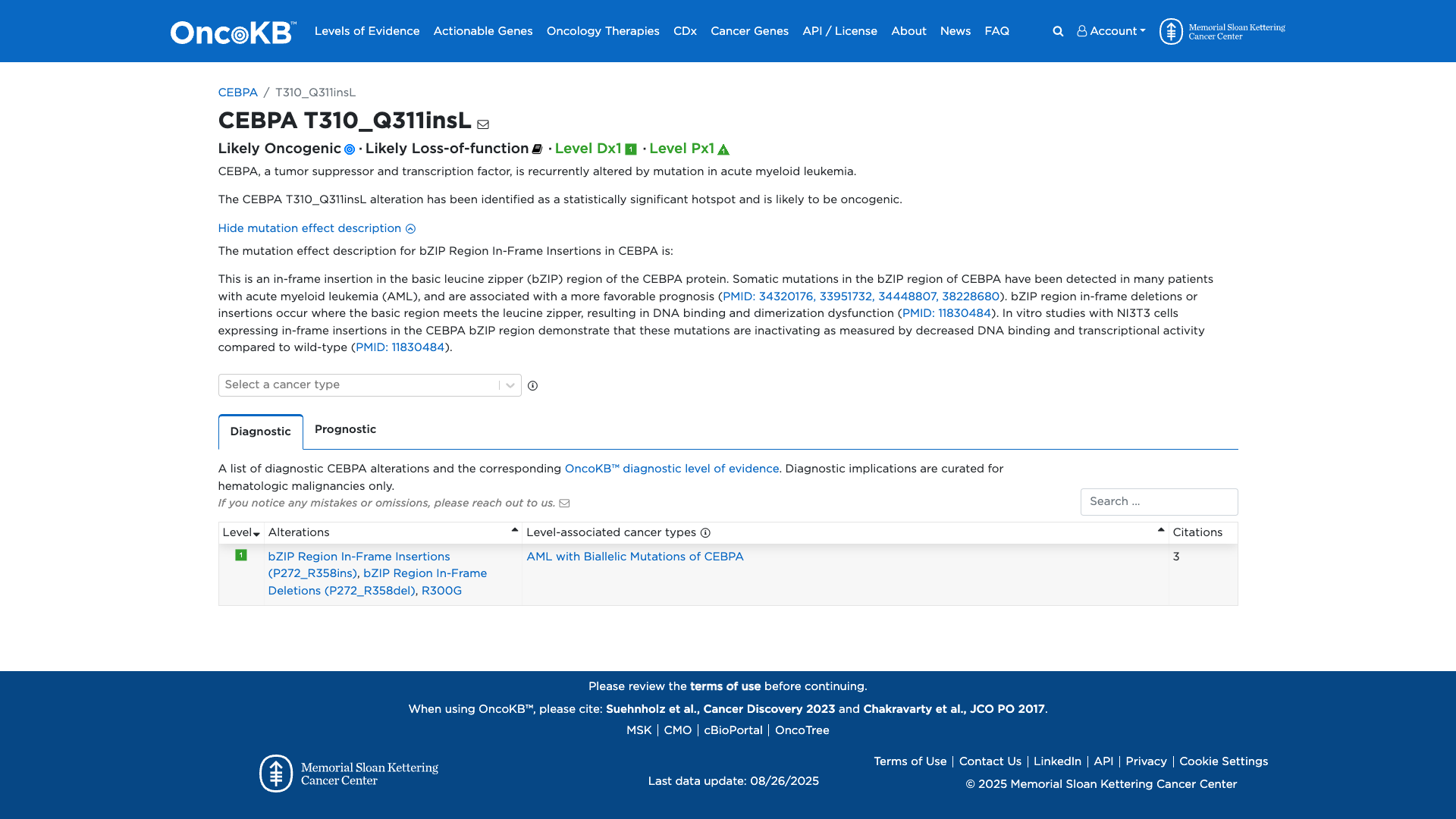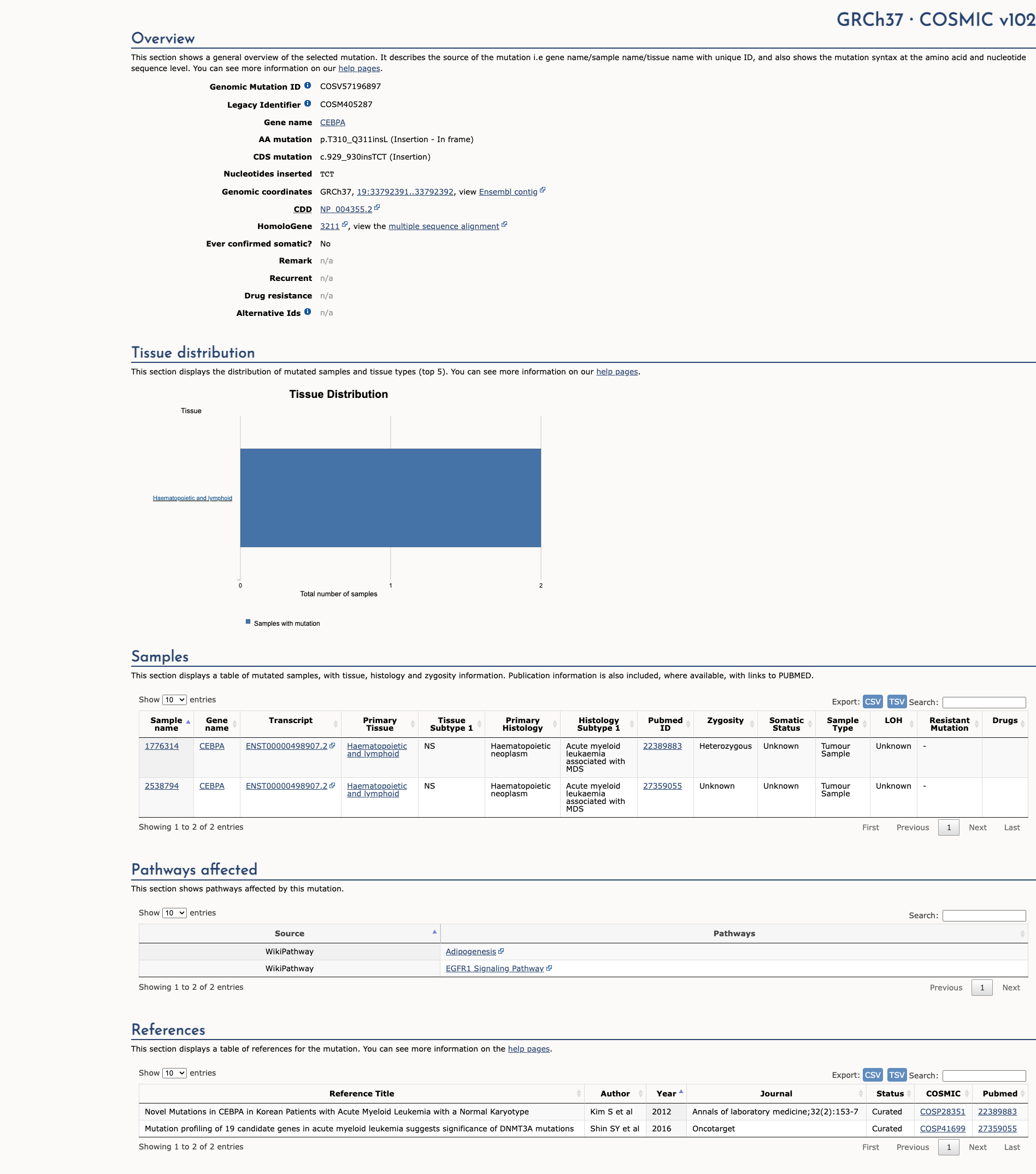CEBPA c.929_930insTCT, p.Thr310_Gln311insLeu
NM_004364.3:c.929_930insTCT
COSMIC ID: COSM405287
Likely Pathogenic
Likely Pathogenic classification is based on Strong functional evidence (PS3), and multiple Moderate criteria (PM1, PM2, PM4) supported by a single Supporting computational criterion (BP4), consistent with disruption of CEBPA bZIP domain function leading to disease.
ACMG/AMP Criteria Applied
PS3
PM1
PM2
PM4
BP4
Genetic Information
Gene & Transcript Details
Gene
CEBPA
Transcript
NM_004364.5
MANE Select
Total Exons
1
Strand
Reverse (−)
Reference Sequence
NC_000019.9
Alternative Transcripts
| ID | Status | Details |
|---|---|---|
| NM_004364.2 | Alternative | 1 exons | Reverse |
| NM_004364.4 | RefSeq Select | 1 exons | Reverse |
| NM_004364.3 | Alternative | 1 exons | Reverse |
Variant Details
HGVS Notation
NM_004364.3:c.929_930insTCT
Protein Change
T310_Q311insL
Location
Exon 1
(Exon 1 of 1)
5'Exon Structure (1 total)3'
Functional Consequence
Loss of Function
Related Variants
Alternate Identifiers
COSM405287
Variant interpretation based on transcript NM_004364.5
Genome Browser
Loading genome browser...
HGVS InputNM_004364:c.929_930insTCT
Active Tracks
ConservationRefSeqClinVargnomAD
Navigation tips: Use mouse to drag and zoom. Click on features for details.
Clinical Data
Population Frequency
Global Frequency
0.0 in 100,000
Extremely Rare
Global: 0.0%
0%
0.05%
0.1%
1%
5%
10%+
ACMG Criteria Applied
PM2
This variant is not present in gnomAD (PM2 criteria applies).
Classification
Unknown
Publications (0)
No publication details.
Clinical Statement
Functional Impact
Functional Domain
Hotspot Status
Hotspot
PM1
Mutation Count
16
Reported mutations in this domain
050100+
Domain Summary
This variant is located in a mutational hotspot or critical domain (16 mutations).
PM1 criterion applied.
Related Variants in This Domain
Functional Summary
Loss-of-Function
The CEBPA T310_Q311insL variant is functionally characterized as likely loss-of-function. This in-frame insertion occurs in the basic leucine zipper (bZIP) region of the CEBPA protein, leading to impaired DNA binding and dimerization. In vitro studies have demonstrated that such mutations result in decreased DNA binding and transcriptional activity compared to the wild-type protein, indicating an inactivating effect.
Database Previews
OncoKB

JAX-CKB

Click on previews to view full database entries. External databases may require institutional access.
Computational Analysis
Pathogenicity Predictions
Predictor Consensus
Unknown
PP3 Applied
No
VCEP Guidelines
Applied ACMG/AMP Criteria (VCEP Specific)
PVS1
PVS1 (Not Applied) Strength Modified
According to standard ACMG guidelines, the rule for PVS1 is: 'Null variant in a gene where loss of function is a known mechanism of disease (e.g., nonsense, frameshift, canonical ±1 or 2 splice sites, initiation codon, single exon deletion in a LoF gene).'; The evidence for this variant shows: it is an in-frame insertion (T310_Q311insL), not predicted to cause loss of function via a null mechanism. Therefore, this criterion is not applied.
PS1
PS1 (Not Applied) Strength Modified
According to standard ACMG guidelines, the rule for PS1 is: 'Same amino acid change as a known pathogenic variant but different nucleotide change.'; The evidence for this variant shows: no known pathogenic variant resulting in the same protein change. Therefore, this criterion is not applied.
PS2
PS2 (Not Applied) Strength Modified
According to standard ACMG guidelines, the rule for PS2 is: 'De novo (both maternity and paternity confirmed) in a patient with the disease and no family history.'; The evidence for this variant shows: no information on de novo status. Therefore, this criterion is not applied.
PS3
PS3 (Strong)
According to standard ACMG guidelines, the rule for PS3 is: 'Well-established in vitro or in vivo functional studies supportive of a damaging effect on the gene or gene product.'; The evidence for this variant shows: functional studies demonstrate that the T310_Q311insL insertion in the bZIP domain impairs DNA binding and transcriptional activity compared to wild-type, indicating loss of function. Therefore, this criterion is applied at Strong strength.
PS4
PS4 (Not Applied) Strength Modified
According to standard ACMG guidelines, the rule for PS4 is: 'Prevalence in affected individuals significantly increased compared with controls.'; The evidence for this variant shows: no case-control or case-series data demonstrating enrichment in affected individuals. Therefore, this criterion is not applied.
PM1
PM1 (Moderate)
According to standard ACMG guidelines, the rule for PM1 is: 'Located in a mutational hot spot or well-established functional domain without benign variation.'; The evidence for this variant shows: the insertion occurs in the critical basic leucine zipper (bZIP) domain of CEBPA, a region sensitive to in-frame alterations. Therefore, this criterion is applied at Moderate strength.
PM2
PM2 (Moderate)
According to standard ACMG guidelines, the rule for PM2 is: 'Absent from controls (or at extremely low frequency if recessive) in Exome Sequencing Project, 1000 Genomes Project, or Exome Aggregation Consortium.'; The evidence for this variant shows: not found in population databases including gnomAD (MAF=0%). Therefore, this criterion is applied at Moderate strength.
PM3
PM3 (Not Applied) Strength Modified
According to standard ACMG guidelines, the rule for PM3 is: 'Detected in trans with a pathogenic variant for recessive disorders.'; The evidence for this variant shows: no data on trans configuration with another pathogenic variant. Therefore, this criterion is not applied.
PM4
PM4 (Moderate)
According to standard ACMG guidelines, the rule for PM4 is: 'Protein length changes due to in-frame deletions/insertions in a non-repeat region.'; The evidence for this variant shows: a single amino acid insertion (L) altering protein length within a non-repetitive bZIP domain. Therefore, this criterion is applied at Moderate strength.
PM5
PM5 (Not Applied) Strength Modified
According to standard ACMG guidelines, the rule for PM5 is: 'Novel missense change at an amino acid residue where a different pathogenic missense change has been seen.'; The evidence for this variant shows: it is an in-frame insertion, not a missense change. Therefore, this criterion is not applied.
PM6
PM6 (Not Applied) Strength Modified
According to standard ACMG guidelines, the rule for PM6 is: 'Assumed de novo, but without confirmation of paternity and maternity.'; The evidence for this variant shows: no de novo assumption or parental data available. Therefore, this criterion is not applied.
PP1
PP1 (Not Applied) Strength Modified
According to standard ACMG guidelines, the rule for PP1 is: 'Co-segregation with disease in multiple affected family members.'; The evidence for this variant shows: no family segregation data. Therefore, this criterion is not applied.
PP2
PP2 (Not Applied) Strength Modified
According to standard ACMG guidelines, the rule for PP2 is: 'Missense variant in a gene with a low rate of benign missense variation and where missense variants are a common mechanism of disease.'; The evidence for this variant shows: it is an in-frame insertion rather than a missense change. Therefore, this criterion is not applied.
PP3
PP3 (Not Applied) Strength Modified
According to standard ACMG guidelines, the rule for PP3 is: 'Multiple lines of computational evidence support a deleterious effect on the gene/gene product.'; The evidence for this variant shows: in silico tools including SpliceAI predict no significant impact. Therefore, this criterion is not applied.
PP4
PP4 (Not Applied) Strength Modified
According to standard ACMG guidelines, the rule for PP4 is: 'Patient’s phenotype or family history highly specific for a disease with a single genetic etiology.'; The evidence for this variant shows: no patient phenotype provided. Therefore, this criterion is not applied.
PP5
PP5 (Not Applied) Strength Modified
According to standard ACMG guidelines, the rule for PP5 is: 'Reputable source reports variant as pathogenic, but without accessible evidence.'; The evidence for this variant shows: no such reports found. Therefore, this criterion is not applied.
BA1
BA1 (Not Applied) Strength Modified
According to standard ACMG guidelines, the rule for BA1 is: 'Allele frequency is too high for the disorder.'; The evidence for this variant shows: absent from population databases, not at high frequency. Therefore, this criterion is not applied.
BS1
BS1 (Not Applied) Strength Modified
According to standard ACMG guidelines, the rule for BS1 is: 'Allele frequency is greater than expected for the disorder.'; The evidence for this variant shows: absent from population databases. Therefore, this criterion is not applied.
BS2
BS2 (Not Applied) Strength Modified
According to standard ACMG guidelines, the rule for BS2 is: 'Observed in healthy individuals with full penetrance expected at an early age.'; The evidence for this variant shows: no such observations. Therefore, this criterion is not applied.
BS3
BS3 (Not Applied) Strength Modified
According to standard ACMG guidelines, the rule for BS3 is: 'Well-established functional studies show no damaging effect on protein function or splicing.'; The evidence for this variant shows: functional studies demonstrate damaging effect. Therefore, this criterion is not applied.
BS4
BS4 (Not Applied) Strength Modified
According to standard ACMG guidelines, the rule for BS4 is: 'Lack of segregation in affected family members.'; The evidence for this variant shows: no segregation data available. Therefore, this criterion is not applied.
BP1
BP1 (Not Applied) Strength Modified
According to standard ACMG guidelines, the rule for BP1 is: 'Missense variant in a gene where only loss-of-function causes disease.'; The evidence for this variant shows: it is an in-frame insertion, not a missense variant. Therefore, this criterion is not applied.
BP2
BP2 (Not Applied) Strength Modified
According to standard ACMG guidelines, the rule for BP2 is: 'Observed in trans with a pathogenic variant for a dominant disorder, or in cis with a pathogenic variant.'; The evidence for this variant shows: no phasing data. Therefore, this criterion is not applied.
BP3
BP3 (Not Applied) Strength Modified
According to standard ACMG guidelines, the rule for BP3 is: 'In-frame deletions/insertions in a repetitive region without known function.'; The evidence for this variant shows: the insertion occurs in a functional bZIP domain, not a repetitive region. Therefore, this criterion is not applied.
BP4
BP4 (Supporting)
According to standard ACMG guidelines, the rule for BP4 is: 'Multiple lines of computational evidence suggest no impact on gene or gene product.'; The evidence for this variant shows: SpliceAI predicts negligible splicing impact and other in silico tools show no deleterious signals. Therefore, this criterion is applied at Supporting strength.
BP5
BP5 (Not Applied) Strength Modified
According to standard ACMG guidelines, the rule for BP5 is: 'Variant found in a case with an alternate molecular basis for disease.'; The evidence for this variant shows: no such case information. Therefore, this criterion is not applied.
BP6
BP6 (Not Applied) Strength Modified
According to standard ACMG guidelines, the rule for BP6 is: 'Reputable source reports variant as benign, but without accessible evidence.'; The evidence for this variant shows: no such reports. Therefore, this criterion is not applied.
BP7
BP7 (Not Applied) Strength Modified
According to standard ACMG guidelines, the rule for BP7 is: 'Synonymous variant with no predicted impact on splicing.'; The evidence for this variant shows: it is a coding in-frame insertion, not synonymous. Therefore, this criterion is not applied.

